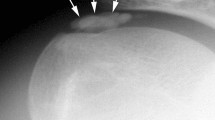Abstract
Purpose
The lacertus fibrosus (LF) is involved in various surgical procedures. However, the anatomy, morphometry, topography and biomechanical involvements of LF are not clear. The purpose of this study was to determine the anatomical and morphometric variations of LF, and to correlate this with anthropometric and morphometric measurements of the upper limb. Furthermore, the presence or absence of a deep layer of LF was verified using forearm cross-sections and dissections.
Methods
This anatomical study was performed by observation of dissections and transverse sections obtained from 50 cadavers. Morphometric analyses [length and width of LF and biceps tendon, stature, length of upper limb, forearm, bi-epicondylar width, forearm perimeter, biceps brachii muscle perimeter (BBm)] were also performed.
Results
The results demonstrated that there was no significant correlation between LF morphology and morphometric upper limb measurements. The deep layer of LF was observed in all specimens.
Conclusion
Results of this paper indicate that the LF presents individual characteristics such as length and width. The deeper layer of LF was observed on all specimens. The possible role of LF in force transmission during flexion, BBm moment arm adjustment and supination reduction is discussed in view of these results.



Similar content being viewed by others
References
Blasi M, de la Fuente J, Martinoli C et al (2013) Multidisciplinary approach to the persistent double distal tendon of the biceps brachii. Surg Radiol Anat. doi:10.1007/s00276-013-1136-y
Benjamin M (2009) The fascia of the limbs and back—a review. J Anat 214:1–18
Chau N, Pétry D, Bourgkard E et al (1997) Comparison between estimates of hand strengths with sex and age with and without anthropometric data in healthy working people. Eur J Epidemiol 13(3):309–316
Chadwick E, Blana D, van den Bogert A et al (2009) A real-time 3-D musculoskeletal model for dynamic simulation of arm movements. IEEE Trans Biomed Eng 56:941–948
Congdon ED, Fish HS (1953) The chief insertion of the bicipital aponeurosis is on the ulna. Anat Rec 116(4):395–401
Cucca YY, McLay SVB, Okamoto T et al (2009) The biceps brachii muscle and its distal insertion: observations of surgical and evolutionary relevance. Surg Radiol Anat 32(4):371–373
Dirim B, Brouha SS, Pretterklieber ML et al (2008) Terminal bifurcation of the biceps brachii muscle and tendon: anatomic considerations and clinical implications. AJR 191(6):248–255
Eames MHA, Bain GI, Fogg QA et al (2007) Distal biceps tendon anatomy: a cadaveric study. J Bone Joint Surg 89:1044–1049
Guimberteau JC, Sentucq-Rigall J, Panconi B et al (2005) Introduction à la connaissance du glissement des structures sous-cutanées humaines. Annales de chirurgie Plastique Esthétique 50(1):19–34
Gordon KD, Pardo RD, Johnson JA et al (2004) Electromyographic activity and strength during maximum isometric pronation and supination efforts in healthy adults. J Orthop Res R22:208–213
Hocking DC, Titus PA, Sumagin R et al (2008) Extracellular matrix fibronectin mechanically couples skeletal muscle contraction with local vasodilation. Circ Res 102(3):372–379
Huijing PA, Maas H, Baan GC (2003) Compartmental fasciotomy and isolating a muscle from neighboring muscles interfere with myofascial force transmission within the rat anterior crural compartment. J Morphol 256(3):306–321
Kulshreshtha R, Singh R, Sinha J et al (2007) Anatomy of the distal biceps brachii tendon and its clinical relevance. Clin Orthop Relat Res 456:117–120
Landa J, Bhandari S, Strauss EJ et al (2008) The effect of repair of the lacertus fibrosus on distal biceps tendon repairs: a biomechanical, functional, and anatomic study. Am J Sports Med 37(1):120–123
Manske PR, Langewisch KR, Strecker WB (2001) Anterior elbow release of spastic elbow flexion deformity in children with cerebral palsy. J Pediatr Orthop 21(6):772–777
Nielsen K (1987) Partial rupture of the distal biceps brachii tendon: a case report. Acta Orthop Scand 58:287–288
Olivier G (1960) Pratique anthropologique, Première partie: Anthropologie du vivant, Edit Vigot frères
Poirier P, Charpy A (1896) Traité d’anatomie humaine-Muscles du membre thoracique, vol 2. Masson et Compagnie, Paris, pp 95–99
Seitz WH Jr, Matsuoka H, McAdoo J et al (2007) Acute compression of the median nerve at the elbow by the lacertus fibrosus. J Should Elb Surg 16(1):91–94
Stecco A, Macchi V, Stecco C et al (2009) Anatomical study of myofascial continuity in the anterior region of the upper limb. J Bodyw Mov 13(1):53–62
Stecco C, Gagey O, Macchi V et al (2007) Tendinous muscular insertions onto the deep fascia of the upper limb. Morphologie 91:29–37
Testut L (1884) Les anomalies musculaires chez l’homme expliquées par l’anatomie comparée-leur importance en anthropologie. Masson, Paris
Vanhees M, van Riet RP (2012) Reconstruction after distal biceps tendon rupture. JOTR 16:2–8
Vasiliauskas R, Dijkers M, Abela MB et al (1995) Characteristics in addition to size of the contralateral hand predict hand volume but are clinically useful. J Hand Ther 8(4):258–263
Acknowledgments
The authors are grateful to Mr. H. Bajou, Mr. P. Sanders and Mr. J-L Sterckx for their technical support.
Conflict of interest
The authors declare that they have no conflict of interest. I declare that all authors that have participated to the study and to the redaction of this manuscript have no financial and personal relationships with other people or organizations that could inappropriately influence this work.
Author information
Authors and Affiliations
Corresponding author
Electronic supplementary material
Below is the link to the electronic supplementary material.
Rights and permissions
About this article
Cite this article
Snoeck, O., Lefèvre, P., Sprio, E. et al. The lacertus fibrosus of the biceps brachii muscle: an anatomical study. Surg Radiol Anat 36, 713–719 (2014). https://doi.org/10.1007/s00276-013-1254-6
Received:
Accepted:
Published:
Issue Date:
DOI: https://doi.org/10.1007/s00276-013-1254-6




